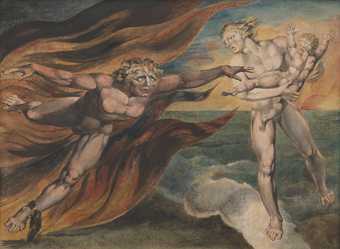
William Blake
The Good and Evil Angels
(1795–?c.1805)
Tate
The term comes from the Greek word ikon meaning image. An icon was originally a picture of Christ on a panel used as an object of devotion in the orthodox Greek Church from at least the seventh century on. Hence the term icon has come to be attached to any object or image that is outstanding or has a special meaning attached to it.
An iconography is a particular range or system of types of image used by an artist or artists to convey particular meanings. For example in Christian religious painting there is an iconography of images such as the lamb which represents Christ, or the dove which represents the Holy Spirit. In the iconography of classical myth however, the presence of a dove would suggest that any woman also present would be the goddess Aphrodite or Venus, so the meanings of particular images can depend on context.
In the eighteenth century William Blake invented a complex personal iconography to illustrate his vision of man and God, and much scholarship has been devoted to interpreting it. In the twentieth century the iconography of Pablo Picasso’s work is mostly autobiographical, while Joseph Beuys developed an iconography of substances such as felt, fat and honey, to express his ideas about life and society. Iconography (or iconology) is also the academic discipline of the study of images in art and their meanings.
